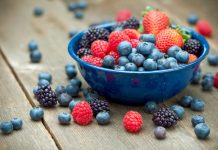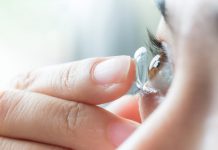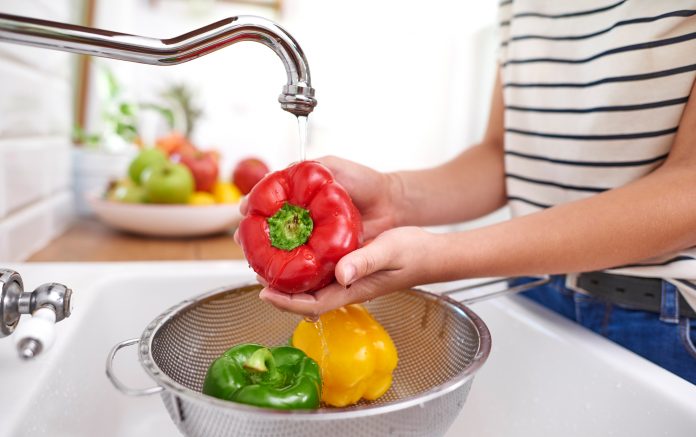The new coronavirus pandemic has raised a lot of pressing questions about things that used to seem pretty set in stone. When it comes to how to wash fruit and vegetables, for instance, what used to be a simple question of cleanliness has taken on a new level of gravity. We know that the new coronavirus appears to spread mainly through respiratory droplets from people who have the infection. But we also know it’s possible (though seemingly less likely, based on current research) to pick it up by touching contaminated objects and then touching your face. Those facts can make the produce section of the grocery store somewhat nerve-racking. Does it matter if someone with COVID-19 coughed, sneezed, talked, or breathed too close to the apple you’re about to add to your cart? Are you at risk if someone with the virus on their fingers picked up that zucchini you need for dinner, then put it back on the shelf?
Here, we’ve broken down how to wash fruit and vegetables to stay as safe as possible right now.
The new coronavirus could theoretically be on your produce before you wash it.
You’re probably highly aware of this now thanks to worldwide talk of an invisible virus, but even when a piece of produce appears to be squeaky clean, it probably isn’t, Philip Tierno, Ph.D., a clinical professor of microbiology and pathology at NYU Langone Medical Center, tells SELF. Just because there’s no visible dirt doesn’t mean it’s not covered in microbes and potentially harmful pathogens. “There’s a whole host of people that handle raw fruits and vegetables,” Tierno says, “including the growers, the pickers, the truckers—many hands which contain different types of germs, potentially pathogens.” Poor farming practices can also contaminate your produce.
To be clear, according to the U.S. Food and Drug Administration (FDA), there is currently no evidence of food or food packaging being linked with cases of COVID-19. And, per the Centers for Disease Control and Prevention (CDC), although we don’t know exactly how long the new coronavirus can hang around on surfaces, we do know that this group of viruses tends to have “poor survivability” on surfaces overall. Experts believe this translates into a very low risk of getting the new coronavirus from food or food packaging that is shipped over days or weeks at normal, refrigerated, or frozen temperatures.
Still, with so many unknowns circulating along with the virus, it’s understandable if you feel like taking some extra precautions and want to know how to wash fruit and vegetables as well as you can. And that’s fine—washing fruit and vegetables was a recommended practice even before this pandemic because, clearly, your produce can come into contact with a lot of stuff before it winds up at home with you.
Based on what we know right now, though, the biggest pathogenic threat from produce isn’t the new coronavirus. Instead, it’s various pathogens that can cause foodborne illness. The FDA reports that every year, around 48 million people in the U.S. contract foodborne illnesses from products contaminated with pathogens like salmonella, E. coli, listeria, norovirus, and hepatitis A.
The good news is that there are agricultural standards in place to minimize the number of pathogens entering the produce system, Randy Worobo, Ph.D., professor of food microbiology at Cornell University, tells SELF. When it comes to the new coronavirus specifically, the FDA has instructed food facilities to follow guidelines from state and local health departments to minimize the risk of transmitting the virus, like cleaning and sanitizing with products registered by the Environmental Protection Agency (EPA).
Finally, if you’re worried about pesticides, know that the EPA and FDA work together to first establish what level of pesticide residue is safe for human consumption, and then enforce those rules (if you’re interested in getting more details on that, you can read this FDA report).
Is rinsing your fruit and vegetables enough?
The reality is that no organizational body that issues guidance on food safety, like the FDA or CDC, has released special instructions for how to wash fruit and vegetables in light of the new coronavirus pandemic. Because the risk of getting the illness from food seems to be so low, there aren’t new produce-washing safety steps we should all be taking. (Yet, at least.)
With that in mind, it might be helpful to know that experts say washing produce with water is usually enough to remove most stray pathogens, and that at the end of the day, consuming something with a few germs on it likely won’t make most people sick. Unless someone is immunocompromised, the human body can generally do a good job of dealing with a few unsavory microbes here and there, says Worobo. (If you are immunocompromised for some reason, like taking immune-suppressing drugs for a health condition, you may want to ask your doctor about specific concerns you have about avoiding the new coronavirus from food sources and elsewhere.) Rinsing your produce will also remove some pesticide residue, Worobo says, adding that there may still be some on your fruit and vegetables, but the amount is so small that it doesn’t seem to pose any real threat.
When it comes to big foodborne illness outbreaks, it’s sort of out of your hands as the consumer. Outbreaks typically depend way more on systemic agriculture practices at farms, says Worobo. If a food has become so contaminated that it’s making people sick, chances are there are a lot of pathogens on it—way more than normal—and those pathogens are likely deeply entrenched in the fruit or veggie, versus just sitting on the surface. In these cases, rinsing won’t be enough to get them off and make them safe, Worobo says, which is why health officials err on the side of caution and advise consumers to throw out potentially contaminated foods. (Worobo also says it’s a good idea to avoid buying anything with a visible bruise or cut because that can be an entry point for pathogens to infect the produce from the inside.)
Here’s how to wash most fruit and vegetables.
First things first—and this is especially important given the new coronavirus pandemic—before you do anything with your produce, make sure to wash your hands for at least 20 seconds following these steps. “Whatever [microbes] are present on your hands will easily be transferred to the food you are preparing unless you wash them first,” Mary Liz Wright, M.S., food safety expert and nutrition and wellness educator at the University of Illinois Extension College of Agricultural, Consumer, and Environmental Sciences, tells SELF. This is one of the four important food safety tips experts recommend to prevent foodborne illness, along with things like cleaning your utensils and surfaces. You can read more about those tips here.
Now that we’ve got that all-important disclaimer out there, rinsing produce with running water and rubbing it with your hands is sufficient to clean the majority of fruit and vegetables enough to eat. In most cases—we’re talking your average fruit or vegetable that was grown and handled properly and may have just a few surface germs on it—that’s enough to get rid of 90 to 99 percent of the microbes present, according to the FDA. There’s no need to whip up a vinegar wash or waste money on a fancy produce spray. In fact, the FDA actually does not recommend using any kind of soaps, detergents, or special washes to clean produce. It’s simply not necessary.
Even though it may not seem like you need to wash produce with hard exteriors or peels (like melons, pineapples, and oranges), you actually should, says Worobo. When you cut into these items, you can push microbes from the surface into the part of the produce that you’re going to eat, he explains. So, always wash hard-skinned produce or anything with a peel before you start peeling or cutting it. The FDA recommends using a clean produce brush to more effectively scrub any potential pathogens from the skin. (One example is the Casabella Loop Vegetable Brush; $6, Amazon.)
You don’t technically need to worry about washing any prewashed ready-to-eat produce, according to the FDA. However, if you decide to go for it due to taking an abundance of caution right now, make sure to follow those food safety tips to avoid cross-contamination.
No matter what fruit or vegetable you’re dealing with, Worobo says, you should normally wait to wash it until just before you eat it. Washing produce adds excess moisture and creates an environment that’s more conducive to breeding potentially harmful pathogens, especially in the case of fruit and vegetables that soak up a lot of water, he says. That’s why, in general, it’s best to avoid washing anything right when you get home from the store (unless you’re eating it pronto). If you’ve purchased something at the supermarket that’s particularly dirty and you’d rather wash it before storing it, just be sure to dry it thoroughly before transferring it to the refrigerator, says Wright. The same rule applies if the new coronavirus makes you want to wash all of your produce—visibly dirty or not—before storing it. (Also, while there are no public guidelines about if it’s safe to store your fruit and vegetables in the same produce bags you used to bring them home from the supermarket, if you feel like being extra safe, it’s okay to throw those out immediately or use your own reusable produce bags for each trip.)
Once you’re done washing your fruit and vegetables, you should wash your hands again. That way you’ll make sure your hands and the food are as clean as possible before you start eating and potentially put your fingers close to your mouth.

























